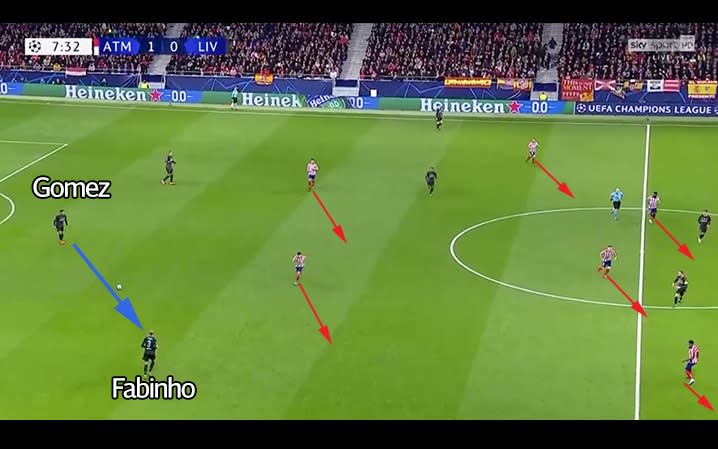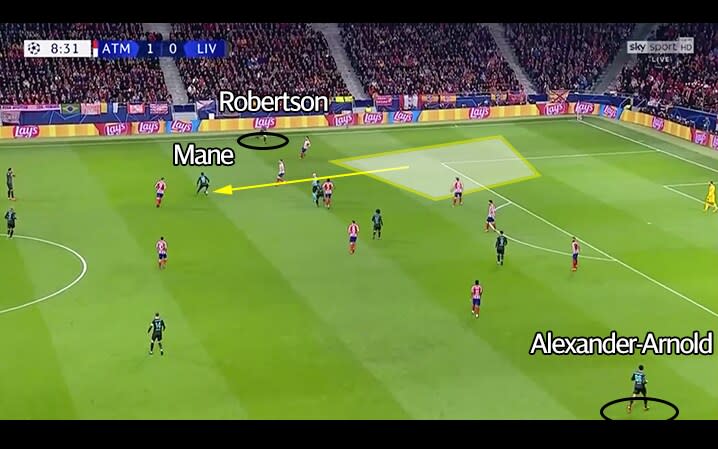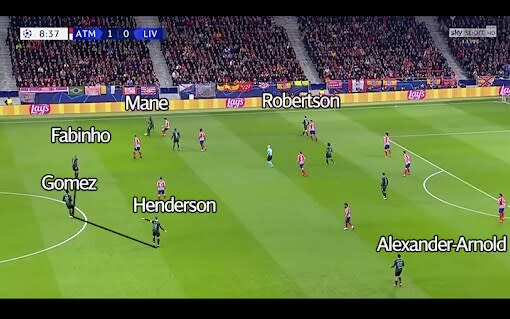How Atletico Madrid beat Liverpool and what Jurgen Klopp must do to turn tie around

Diego Simeone’s Atlético Madrid are a horrible team to play against. They are intense, physical, aggressive, organised, disciplined and devious, and when revved up and roared on by an emotionally charged crowd, near impossible to score against. Even the mighty Liverpool looked nervous in their 1-0 defeat on Tuesday night.
"We're a team that plays as a group,” said Simeone after the match. “If the attackers hadn't participated in the defensive work, the team wouldn't have done what it did.”
This is what he meant:
How Atlético Madrid defend
Atlético play a highly defensive 4-4-2 designed to show the play wide and encourage their opponents to open up and send players forward to outnumber them in attacking areas.
Liverpool's full-backs usually provide attacking width and move high up the pitch but Atlético sat so deep and so compact that by the time a pass had reached Trent Alexander-Arnold on the right, left-midfielder Thomas Lemar had already sprinted out to close it down, backed up by left-back Lodi.
This is what Liverpool were faced with for the majority of the game:

The press starts higher. Alexander-Arnold pushes up the wing during build-up and a midfielder, in this example Fabinho, drops into the space he has left vacant to give Liverpool the passing angles needed to progress play. Atlético's two strikers are positioned centrally and parallel to the centre-backs, to ensure the pass has to go wide and cannot be pinged into the midfield. The 4-4-2 shifts over as the ball moves wide.

Atlético's midfielders stand just in front of Liverpool's midfielders just in case a low pass is fired in, allowing them to intercept. This is a midfield block.
Fabinho receives the ball on the right, Atlético have already scuttled over to protect the flank and the forward pass to Alexander-Arnold higher up the wing is now risky. Fabinho has to pass back inside to Joe Gomez which means Atlético need to move forwards to squeeze the space and provide even fewer options for a pass.

It’s incredibly difficult to break down. Liverpool did as most teams do against a low block and passed the ball from side to side to try and stretch the Atlético shape and create gaps, but the difference between Simeone’s setup and other teams who play in this style is how strong, fast and talented the players are and how aggressively they defend individually. Atlético are essentially a world-class version of Burnley.
The moment a Liverpool player received the ball in the final third, a defender had snapped on to him as though holding onto the other end of a measuring tape. The only option was to release the ball immediately – dangerous around the Atlético box because of the players waiting to counter-attack – or go backwards. With a 1-0 lead, Atlético could control the game in exactly the way they wanted.
How Liverpool can get back in the tie
Liverpool need to be really brave with their passing in the second leg, firing passes more quickly out to the wide full-back or winger and trust their ability to control strongly hit balls. Anfield will make a difference and can help boost the confidence of players to attempt these riskier passes, but the danger is surging forwards and being hit on the counter.
Alexander-Arnold's delivery was poor in the 1-0 defeat and if he simply plays better, Liverpool will create more from the right side and from set pieces. He has created the second most chances of any Liverpool player in the Champions League this season with 10 (Roberto Firmino and Sadio Mané have 13) but in the Premier League he is their most important creative outlet, having provided 67 chances to score in 26 games. Mohamed Salah is second with 43.
One solution to getting more from Alexander-Arnold is have the right winger double up in attacking situations. Atletico push their left-back and left-midfielder onto the Liverpool full-back, with Salah tucked inside closer to the centre-back. If Salah pulls out wide instead, this could potentially create a two v two or two v one on the wing and free up a tiny bit of space for Alexander-Arnold to better deliver early balls towards the back post.
Another trick they could use is have one of the forwards drop out of their position to leave a space for the full-back to attack. Mané did this on the left on occasion, leaving a gap between right centre-back Stefan Savic and right-back Sime Vrsaljko which Andrew Robertson could move into:

This kind of move works against someone like Burnley – a decent side composed of lower mid-table Premier League players – and Robertson has profited from it on several occasions in the past by exploiting a momentary lapse in concentration or positioning error to burst into the box and score or assist, but Vrsaljko is a brilliant, fast, strong, postionally aware right-back coached to cover this precise scenario. Simeone leaves nothing to chance.
Managing the game in the second leg
The second the ball had bounced off Fabinho’s shin and ran through for Saúl Ñíguez to score inside four minutes, Simeone’s gameplan had worked.
Listen to that roar 🤯
Saul Niguez gives Atletico the dream start with a goal inside four minutes!
They are well up for this! pic.twitter.com/vEF4UXgGiG— Football on BT Sport (@btsportfootball) February 18, 2020
There simply are rarely opportunities to hit Atlético on the counter-attack because they attack with so few players but Liverpool might be able to push more forwards and gain an advantage in front of their own fans.
Liverpool stretched the pitch wide to try and create gaps between Atlético players, but Simeone's players stayed compact and narrow. The centre of the pitch was the bit Liverpool had to protect from counters. They did this by having Virgil van Dijk stay deepest as something like a sweeper while Fabinho, Gomez and Jordan Henderson formed a midfield net in the event of possession turning over.

Atlético would win the ball from a loose pass or bad first touch and race up the wing until they were fouled or able to win a free-kick. In the second leg they will do more of the same and Liverpool must take more risks, pushing Henderson further forward to help Alexander-Arnold, or have someone like Georginio Wijnaldum try to beat a midfielder with a burst of acceleration in midfield and get the ball into the forwards. They need to create more chaos in the final third against a rigid, organised defence.
Jürgen Klopp's side registered zero shots on target at the Wanda Metropolitano Stadium and this is what they must address. More risks, overloading the wide areas, better delivery into the box, and getting a better share of refereeing decisions when winning the ball high up the pitch will all help in breaking down the impossibly robust Atlético block. There are no obvious tactical deficiencies to exploit. It's like trying to punch through a bouncy castle wall – Klopp needs to sharpen the knife however he can.
“When you’re playing the champions, in a game like this, there’s an extra motivation and of course we’d like that we competed like this is every game and every competition," said Atlético goalscorer Saúl after the match. "This is almost like a reminder, a telling off, for us too: we would like to be like this all the time.”
It is far easier to destroy than create and this second leg will be hugely challenging, like fighting fire with deep water. The positive for Liverpool is this performance was rare of this season from Atlético and there is – surely – no way they can replicate the extreme intensity of their performance on Tuesday away from home. That alone should give Liverpool more of a chance to score.
As Klopp said in his post-match interview: "Welcome to Anfield. It's not over yet."


